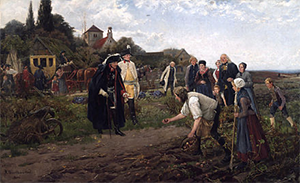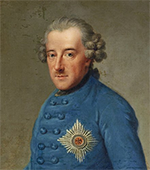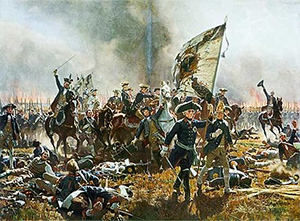Frederick the Great: Prussia's Shining Star
Part 2: Cementing a Reputation
Despite the heavy losses in men, materiel, and money, Prussia was still in a strong state relative to the other European powers. The Prussian economy recovered well enough for Frederick to join in the First Partition of Poland, in 1772, enjoying an infusion of land that created greater economic opportunities. Six years later, Frederick saw off an attempt by the Holy Roman Emperor Joseph II to seize Bavaria. It didn't hurt that Russia was still on Frederick's side. 
Before, during, and after his various wars, Frederick oversaw the growth of his state. He was a keen developer in using new technology, helping to drain marshes and swamps in order to create new farmland and, like his predecessors, championing the construction and linking of canals. Also in the agricultural vein, he introduced both turnips and potatoes; for the latter actions, he is sometimes referred to as the "Potato King." 
As well, Frederick encouraged construction, ordering the building of a handful of famous structures in Berlin, including the Royal Library and the Berlin State Opera. Also among these was St. Hedwig's Cathedral (right), which Frederick designed. Frederick supported the arts, notably painting and especially music and opera. He encouraged philosophers to publish their works and did so himself; he also enjoyed personal correspondence with some famous contemporary philosophers, notably Voltaire, and gave sanctuary to Jean- Jacques Rousseau when the latter faced persecution in France. Frederick also wrote a history of the Seven Years War, a general history of the world during his lifetime, and a set of memoirs. As well, he was an accomplished flute player and wrote several pieces for that instrument. 
Prussia was at peace for the last years of Frederick's life. He remained a very popular figure in hols age. He died on Aug. 17, 1786, at Sanssouci. His nephew Frederick William succeeded him. First page > Born to Right and Rule > Page 1, 2 |
|
Social Studies for Kids
copyright 2002–2025
David White



 Prussia invaded Saxony in 1756, triggering yet another war over Silesia. This one spilled over into a much, much wider conflict, involving most of Europe and featuring fighting in most quadrants of the globe. This was the
Prussia invaded Saxony in 1756, triggering yet another war over Silesia. This one spilled over into a much, much wider conflict, involving most of Europe and featuring fighting in most quadrants of the globe. This was the 
